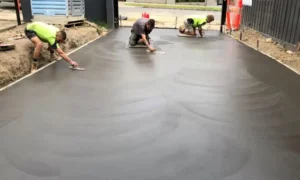Concrete is a versatile and widely used building material known for its strength, durability and flexibility. It is a composite material consisting of three main components: cement, water and aggregate. In this article, we will discuss the role of aggregates in concrete and the importance of concrete vibrations in achieving a strong and durable concrete structure.
Aggregate in Concrete
Aggregates are an essential part of concrete because they make up most of the volume of concrete and have a significant impact on its properties. These are granular materials such as sand, gravel, crushed stone or recycled concrete used in construction. Aggregates fall into two main categories: fine aggregate (generally sand) and coarse aggregate (generally gravel or crushed stone).
Aggregate is an essential part of concrete as it occupies most of the volume of concrete and has a significant influence on its properties. Granular materials such as sand, gravel, crushed stone or recycled concrete used in construction. Aggregates fall into two main categories: fine aggregate (generally sand) and coarse aggregate (generally gravel or crushed stone).
Functions of Aggregate in Concrete
Economic benefits: Aggregate is relatively cheaper than cement and helps reduce the overall cost of concrete. Because they take up a large volume of the concrete mix, they reduce the amount of cement needed and thus reduce labor costs.
Strength and Durability: Aggregates contribute to the strength and durability of concrete by providing a rigid structure that holds the cement paste together. The strength of concrete depends primarily on the strength of the aggregate and the bond between the aggregate and the cement paste.
Dimensional stability: aggregates help maintain the dimensional stability of concrete, reducing the effects of shrinkage and creep. They also minimize the risk of cracks in the concrete due to temperature changes or other external factors.
Workability: The size, shape and texture of the aggregate particles affect the workability of the concrete mixture. A well graded aggregate with a good balance of fine and coarse particles can improve the workability of concrete and make it easier to place, compact and finish.
Concrete Vibrating
Concrete vibration is an important step in the process of concrete placement, as it ensures that the concrete mixture is well formed and does not contain voids. During mixing and pouring, air bubbles and excess water can be trapped in the concrete, which can significantly reduce its strength and durability.
Importance of Concrete Vibrating
Elimination of Air Voids: Concrete vibration helps remove air bubbles trapped in the mix, resulting in denser, stronger concrete.Contractors often choose concrete screed to do this job. Eliminating air voids also reduces the risk of freeze-thaw damage in cold areas because it prevents water from entering and expanding in the concrete.
Improved Bond: Concrete vibration helps achieve a better bond between the cement paste and the aggregate, ultimately leading to a stronger and more durable concrete structure.
Surface finish: Properly agitated concrete provides a smooth surface finish, which not only improves the appearance of the building, but also reduces the permeability of the concrete, making it more resistant to water penetration and corrosion.
Structural Integrity: By ensuring proper compaction and eliminating voids, concrete vibration plays an important role in maintaining the integrity of the concrete structure, preventing premature failure and extending its service life.
Concrete Vibrating Techniques
There are many methods and tools for vibrating concrete, including:
Internal vibrators: sometimes referred to as immersion vibrators or poker vibrators, are the most popular vibrator kinds used to compact concrete. They consist of moving heads attached to flexible shafts that are inserted into the concrete mix for mixing.
External Vibrators: These vibrators are mounted on formwork or concrete surfaces and are used to mix the concrete from the outside. The process is relatively simple: An operator quickly attaches a probe-like internal vibrator to the wet concrete, then slowly pulls it out. They are useful for small or large slabs, walls and columns.
Shakers: These are large, flat tables that vibrate to mix the concrete placed on them. They are mainly used in precast concrete elements such as beams, columns and panels.
In summary, aggregate plays an important role in determining the properties and performance of concrete, and concrete vibration is an important step in achieving a strong, durable and aesthetically pleasing structure. By understanding the importance of these elements and implementing the correct techniques, builders can ensure the longevity and integrity of their concrete structures.



































